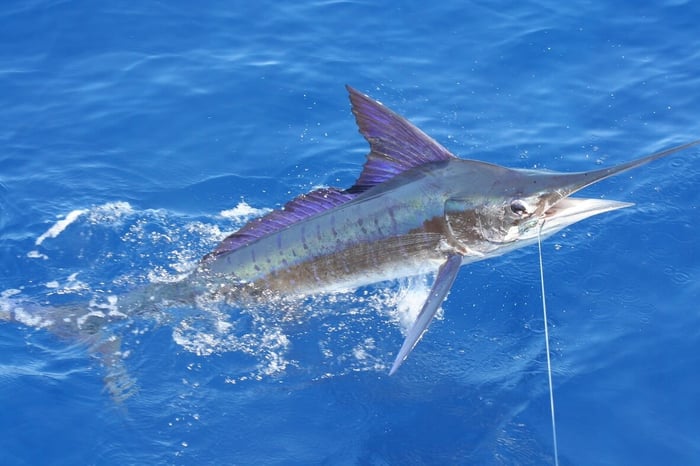Striped marlin flesh is dark and strongly flavoured. It is firmly textured and quite low in moisture.
Most suited to grilling, marlin can also be prepared by baking, poaching, shallow frying or smoking, or eaten raw as sashimi. Marlin is delicious smoked and is a common entrée.
Scientific name: Kajikia audax (formerly Tetrapturus audax)
Family: Istiophoridae
Other names: Pacific striped marlin, stripey, beaky, beak, billfish
Description: Striped marlin have elongated bodies with a long thin pointed bill. They have dark blue or black backs, with 12‑16 blue vertical bars on the lower sides. When the fish is excited, the colour of these bars rapidly changes from blue to lavender via the contraction or expansion of chromatophores (special pigmented cells). The first dorsal fin is dark blue, with the other fins being dark brown and sometimes tinged with blue.
Size (length and weight): Up to about 4 metres in length and 260 kg. Commonly found at 1.6‑2.5 metres and 30‑120 kg.
Life span: Up to about 10 years.
Habitat: Striped marlin occur in tropical to temperate waters of the Pacific and Indian Oceans. Striped marlin are a highly migratory pelagic species that can be found to depths of 289 metres. They are rarely seen in coastal waters, except where sharp drop-offs into deeper water occur. Striped marlin are mostly solitary but form small schools by size during the spawning season. They hunt prey in surface waters at night.
Striped Marlin Species Guide:
Prey: Fish such as sardines, trevally and small tunas, cephalopods and crustaceans.
Predators: Large sharks and toothed whales.
Reproduction: Striped marlin reach reproductive maturity at about 2-3 years of age. Males mature earlier than females. Spawning occurs in summer. Striped marlin are multiple batch spawners with females releasing eggs every few days, with 4‑41 spawning events occurring over the spawning season. Females can produce up to about 120 million eggs per spawning season.
Other notes: Unlike other marlin species striped marlin slash their prey with their bill rather than impaling it. Striped marlin is classified as Near Threatened by the IUCN Red List of Threatened Species.
Striped Marlin Techniques: Striped Marlin are usually located by trolling. Their dorsal fin and/or bill can often be seen cutting through the water behind the trolled bait or lure, making for an exciting visual. While trolling, you should scan the water for fish as they often sun themselves near the surface. When a fish is spotted you can cast a bait in front of them and hope they decide to eat it.
Striped Marlin Lures: Most people troll rubber skirted lures when searching for Striped Marlin. I have had good success using Zukers trolling lures in the 12” size.
Striped Marlin Baits: Larger bait fish such as Pacific Mackerel can be used successfully for Striped Marlin. You can wait until you see one eyeing your trolling lures and then drop a bait back. Always have a casting bait handy in case a fish is spotted on the surface sunning itself. Use circle hooks for a better hookup and better release.
Where to get the big Striped Marlin: The biggest ones are in New Zealand although I have never fished for them there. The Cabo area of Baja sometimes sees huge numbers of these fish in the fall into the winter. They migrate but if they are in the area some boats make some nice double digit scores.


